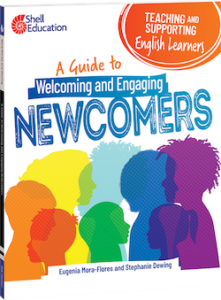Here’s How to Welcome and Engage Newcomers
Teaching and Supporting English Learners: A Guide to Welcoming and Engaging Newcomers
By Eugenia Mora-Flores and Stephanie Dewing
(Shell Educational Publishing, 2023 – Learn more)
Reviewed by Melinda Stewart

There are a lot of resources that claim to be guides for welcoming newcomers but fail to fully deliver. I was pleased that this book revealed itself to be an invaluable resource I can use as I work with colleagues, promoting their understanding of newcomers and helping them make their classroom and their content accessible to our multilingual learners.

Instead, Mora-Flores and Dewing set the tone for the discussion of newcomers by sharing a little background information about various labels and then diving into stories.
People connect through stories, and right away the reader begins to connect with the content and the why of the book. Throughout the chapters, Mora-Flores and Dewing return to the stories of newcomers, constantly reminding the reader of the learner at the heart of the discussion. This biography-driven approach makes the book highly relatable.
After the chapter introducing us to the learners’ stories, I found that the authors used research and scenarios that prompted me to ask questions and at first made me a little frustrated, thinking here we go again… but when I turned the page, the authors were answering the questions I was asking. Unlike many guides that seem to take information and just reorganize it for educators, this guide offers some applicable suggestions.
The ability to anticipate a reader’s questions and concerns is an impressive quality. As an educator begins to ponder potential obstacles or seek specific guidance to answer, “But how do I…?”, the authors’ foresight saves time and instills confidence in the reader, assuring them that the book has been crafted to meet their needs.
Actionable steps from classroom experiences
Throughout the book, Mora-Flores and Dewing draw from personal experience and case studies to present practical strategies and actionable steps that can be implemented at various levels. The authors emphasize the importance of open dialogue, active listening, and cultural sensitivity as key components of successful integration.
One of the book’s greatest strengths is its emphasis on fostering reciprocal relationships between newcomers and the community. The authors explain how integration is a two-way process, stressing that the responsibility is not solely on the newcomers to adapt, but also on the community to create a welcoming environment.
By highlighting the mutual benefits of integration, the authors encourage readers to see newcomers beyond the labels that are given to them by institutions and programs and view them with new eyes, focusing on them as resilient humans who bring assets and new perspectives that will enrich our communities. Systems should be “ready to support their transitions into a new country, culture, and school system.” (12)
I was able to pull a lot of ideas from the book that I would love to implement in my setting, including Newcomer Kits for Families, but (selfishly) I wish there would have been a little more information about how to best work with unaccompanied youth. Not all of our students have families with them.
I appreciate that this group of family-supported newcomers was discussed, but working in a fairly small district, with increasing numbers of SLIFE students who are unaccompanied, I was hoping to see my unaccompanied students and the resources needed to help them discussed more.
I did finish Chapter 3 with a firm reminder of the role of trust, triggers, and the human desire of wanting to be noticed. That is a message I can repeat over and over in our staff meetings and conversations.
Putting student experiences in context
Context. As I read, context is the one word that formed in my thinking over and over. Being mindful of context is not only critical the moment that newcomers walk into our buildings, but also as they engage with people and the content of the classrooms.
“If students are to become fluent in their ability to express their learning in oral and written forms, they need to engage in meaningful interactions that allow for feedback from a range of language users.” (174)
Mora-Flores and Dewing discuss ELD instruction (Direct and Indirect), address both input and output, the obstacles of culture shock and language barrier, and the importance of providing our learners with language support and opportunities to talk.
The community connection
The book is a terrific resource for helping individuals and groups plan for welcoming newcomers into our schools and classroom activities. Although community connections are mentioned, the content is not comprehensive enough to offer a roadmap to navigate the challenges of integration on a larger scale. When discussing community and relationships with parents, the examples are a reiteration of things we’ve heard before, but there were not many new ideas to go beyond the surface level discussion of cultural gaps.
Since community resources were mentioned, I would have been open to reading more about developing cultural sensitivity, cultural humility and suggestions for larger scale implementation within a district or in collaboration with a community outside of the school setting.
Creating inclusive learning environments
The authors’ emphasis on relationships and practicality is evident throughout the book. Each concept is accompanied by actionable steps. These action steps enable educators and instructional coaches to implement the suggested strategies with some ease.
Mora-Flores and Dewing encourage reflection and self-assessment, allowing educators to tailor the approaches to their specific contexts and adapt them to the unique needs of their students and settings. Again, the synthesis of research, student stories and practical application enhances the book’s value, providing a solid foundation for educators looking to make informed decisions.
Read a MiddleWeb article
by co-author Stephanie Dewing
Mora-Flores and Dewing demonstrate their expertise by blending research findings and real-world examples, providing a fairly comprehensive understanding of the challenges faced by newcomers and offering effective strategies for their integration. The book addresses various academic disciplines, expanding the appeal to a larger audience. While the content is highly relevant and beneficial for those working in an educational setting, individuals seeking guidance on broader community integration or non-educational contexts may find the book less applicable to their specific needs.
An immediately useful book for educators
In conclusion, Teaching and Supporting English Learners: A Guide to Welcoming and Engaging Newcomers is a great resource for educators in diverse disciplines. Eugenia Mora Flores and Stephanie Dewing combine research, practical application, and anticipatory guidance to create an immediately useful guide. By providing effective strategies for creative inclusive learning environments, this book equips educators with the tools needed to foster a sense of belonging for newcomers.
Melinda Stewart has been an educator for 30 years. She has an MA in Teaching, Education and Learning and has done graduate work in the areas of English as a Second Language, Reading, and Spanish. She is currently working as a Spanish teacher and ELM coach at Fairmont (MN) Junior Senior High School. Melinda is an MEA and AFT professional development facilitator and trainer who has a deep passion for learning and equity. She was selected district Teacher of the Year in 2022-23.






























